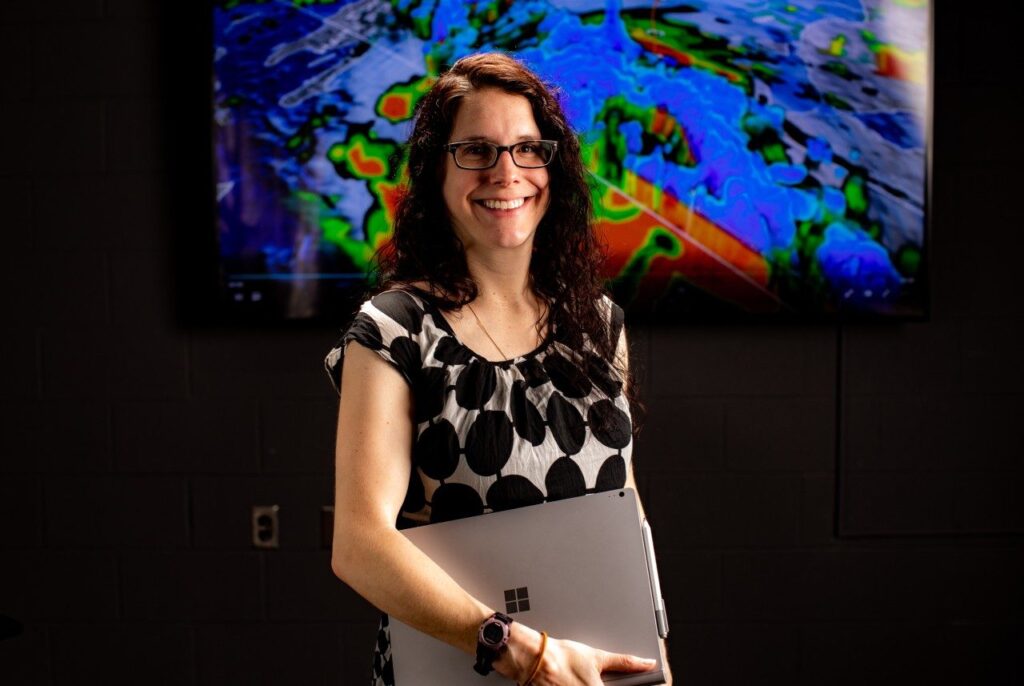As summer approaches, people in the Midwest will start hearing a distinct rising and falling sound playing from speakers erected near city and town centers. This hair-raising howl — which runs for three minutes — is a test of municipal tornado alert systems and a reminder of the risks that summer weather brings.
While weather forecasters and meteorologists have a strong understanding of the correlation between weather conditions in the troposphere — the lowest layer of the Earth’s atmosphere — and tornadoes, there is a critical gap in understanding how conditions in the upper atmosphere can impact tornado frequency.
Recently, College of Natural Resources and Environment Assistant Professor Stephanie Zick collaborated with College of Science Professor Marco Ferreira and Cleveland State University Assistant Professor Mohamed Elkhouly Ph.D. ’17 in a study to understand how weather variables in the troposphere and the stratosphere — the second layer of atmosphere — might impact tornado occurrence in the lower layer where tornadoes occur.
Utilizing broad meteorological data, the research team used a novel analysis method to compare temperature, humidity, and wind variables across four study regions of the United States. The findings — published in the journal PLOS One this past spring — reveal that warm and dry conditions in the stratosphere are a significant predictor of days when tornadoes can be anticipated.
“While interactions between troposphere and stratosphere are generally well-documented, an association with tornadoes is not something that a lot of researchers have found,” said Zick, who teaches in the Department of Geography. “The novel finding of our project is that there is a significant statistical link between stratospheric changes in temperature and humidity and the occurrence of tornadoes.”
Another critical finding was the discovery of an increased presence of the dryline mode — an atmospheric condition traditionally understood to produce the kinds of thunderstorms where tornadoes frequently form — occurring in the northern regions of the central Midwest.
“Anecdotally, we don’t typically think of drylines, which are the delineations between moist and dry air masses, as occurring in regions like Iowa or Illinois,” said Zick, who specializes in the tropical meteorology surrounding cyclones. “But our findings actually show that there is an increasing presence of those modes occurring in the northern regions that we studied.”
Ferreira said one of the challenges of this project was utilizing temperature, humidity, and wind data sets to develop meteorological models that would consider tornado occurrences.
“For this project, we analyzed meteorological data sets that had gigabytes of data, which was a challenge,” said Ferreira, who teaches in the Department of Statistics. “Meteorological data is chiefly observational data, and, as a result, the statistical analysis of the data is more complicated. We have to take into account the spatial and temporal dependencies among the data points.”
To utilize that data, Ferreira used an empirical orthogonal functions (EOF) approach to determine the atmospheric signals that would suggest strong tornado days.
“EOF analysis is a statistical method that allows us to understand spatial patterns in atmospheric processes, overlaid on a map,” said Zick. “The outputs can be interpreted physically in terms of atmospheric processes that are strongly associated with tornado occurrences.”
Ferreira said that a highlight of this project was the opportunity to apply statistical analysis to a new field.
“A famous statistician, John Tukey, once said that the best thing about statistics is that you get to play in everyone’s backyard,” said Ferreira. “In this paper, I got to play in the backyards of meteorology and climate, which was a lot of fun.”

Zick echoed that advancements in meteorological science are increasingly going to rely on research approaches that work across disciplines and areas of expertise.
“Because I work at the intersection between geography and meteorology, my work is already very interdisciplinary,” said Zick, an affiliate faculty member of the Center for Coastal Studies at Virginia Tech. “I use a lot of geographic methods such as spatial analysis in my research, and I look to collaborate with researchers who want to utilize my expertise to take on critical research questions.”
As the season for severe weather approaches, people are encouraged to familiarize themselves with area tornado alerts and warnings, consider enrolling in a wireless emergency alert system for severe weather, and discuss making an emergency plan for their homes or workplaces.
– Krista Timney

